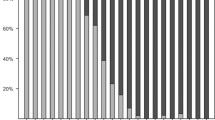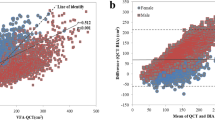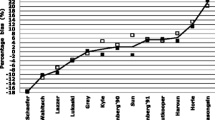Abstract
The frequent clinical use of bioelectrical impedance analysis (BIA) devices has made clinical evaluations of BIA-based parameters mandatory. This study was performed to define new cutoff points for the fat mass index, fat-free mass index, and percent body fat for overweight and obese men living in Riyadh, KSA. Three hundred sixty-two male subjects aged 18 to 62 years were enrolled in this cross-sectional study. The participants were divided into two groups; one group was assessed with an InBody 720 (n = 179) device, and the other group was assessed with a Tanita BC-418 (n = 183) device. Fat mass, fat mass index (FMI), fat-free mass, fat-free mass index (FFMI), and percent body fat (PBF) were measured. In addition, anthropometric measures, including weight, height, body mass index (BMI), waist circumference, hip circumference, waist hip ratio, and mid-arm circumference were included. Pearson correlation coefficients, Kappa analyses, and ROC curves were used. FMI exhibited the strongest positive correlation with BMI among all of the measured BIA-based parameters in both the InBody and Tanita groups (r = 0.916 and 0.958, respectively, P < 0.00001). ROC curves indicated that FMI was the most accurate parameter for the diagnosis of obesity in both groups (AUCs = 0.970 and 0.980). The FMI, FFMI, and PBF cutoff values with the best sensitivities and specificities in both groups were 7.8 vs. 6.7 kg/m2, 19.2 vs. 20.7 kg/m2, and 27.8 vs. 24 %, respectively, based on the WHO criteria for the diagnosis of obesity in Asian population. FMI was the best predictor of obesity among all of the BIA-based parameters. Considerable differences were noted between the different machines. Knowledge of device-specific cutoff points would increase the clinical value of BIA in the diagnosis of obesity.





Similar content being viewed by others
References
Fontaine KR, Redden DT, Wang C, et al. Years of life lost due to obesity. JAMA. 2003;289:187–93.
Luciano A, Livieri C, Di Pietro ME, Bergamaschi G, Maffeis C. Definition of obesity in childhood: criteria and limits. Minerva Pediatr. 2003;55(5):453–9.
Zeng Q, Dong SY, Sun XN, Xie J, Cui Y. Percent body fat is a better predictor of cardiovascular risk factors thanbody mass index. Braz J Med Biol Res. 2012;45:591–600.
Carpenter CL, Yan E, Chen S, Hong K, Arechiga A, Kim WS, et al. Body fat and body-mass index among a multi-ethnic sample of college-age men and women. J Obes Hindawi Publ Corp. 2013;790654:1–7.
Whitlock G, Lewington S, Sherliker P, Clarke R, Emberson J, Halsey J, et al. Body-mass index and cause-specific mortality in 900,000 adults: collaborative analyses of 57prospective studies. Lancet. 2009;373:1083–96.
Evans EM, Rowe DA, Racette SB, Ross KM, McAuley E. Is the current BMI obesity classification appropriate for black and white postmenopausal women? IntJ Obes. 2006;30(5):837–43.
Frankenfield DC, Rowe WA, Cooney RN, Smith JS, Becker D. Limits of body mass index to detect obesity and predictbody composition. Nutrition. 2001;17(1):26–30.
Romero-Corral A, Somers VK, Sierra-Johnson J, et al. Accuracy of body mass index in diagnosing obesity in the adult general population. Int J Obes (Lond). 2008;32(6):959–66.
Chang CJ, Wu CH, Chang CS, et al. Low body mass index but high percent body fat in Taiwanese subjects: implications of obesity cutoffs. Int J Obes (Lond). 2003;27(2):253–9.
Kyle UG, Bosaeus I, De Lorenzo AD, Deurenberg P, Elia M, Manuel Gómez J, et al. ESPEN. Bioelectrical impedance analysis-part II: utilization in clinical practice. Clin Nutr. 2004;23(6):1430–53.
Kyle UG, Bosaeus I, De Lorenzo AD, Deurenberg P, Elia M, Manuel Gómez J, et al. ESPEN. Bioelectrical impedance analysis-part I: review of principles and methods. Clin Nutr. 2004;23(5):1226–43.
Gupta N, Balasekaran G, Victor Govindaswamy V, et al. Comparison of body composition with bioelectric impedance (BIA) and dual energy X-ray absorptiometry (DEXA) among Singapore Chinese. J Sci Med Sport. 2011;14(1):33–5.
WHO Expert Committee on Physical Status. Physical status: the use and interpretation of anthropometry. WHO Tech Rep Ser. 1995;854:1–416.
WHO Expert Consultation. Appropriate body-mass index for Asian populations and its implications for policy and interventionstrategies. Lancet. 2004;363:157–63.
Schutz Y, Kyle UUG, Pichard C. Fat-free mass index and fat mass index percentiles in Caucasians aged 18–98 years. Int J Obes. 2002;26:953–60.
Wang J, Rennie KL, Gu W, Li H, Yu Z, Lin X. Independent associations of body-size adjusted fat mass and fat-free mass with the metabolic syndrome in Chinese. Ann Hum Biol. 2009;36:110–21.
Prado CM, Siervo M, Mire E, Heymsfield SB, Stephan BC, Broyles S, et al. A population-based approach to define body-composition phenotypes. Am J Clin Nutr. 2014;99(6):1369–77.
Kang DH, Guo LF, Guo T, Wang Y, Liu T, Feng XY, Che XQ. Association of body composition with bone mineral density in northern Chinese men by different criteria for obesity. J Endocrinol Investig. 2014. [Epub ahead of print].
Ribeiro EA, Leall DP, Assis MA. Diagnostic accuracy of anthropometricindices in predicting excess body fat among 7 to 10-year-old children. Rev Bras Epidemiol. 2014;243–254.
Zhao D, Zhang Y. Body mass index (BMI) predicts percent body fat better than body adiposity index (BAI) in school children. Anthropol Anz. 2015. doi:10.1127/anthranz/2015/0499 [Epub ahead of print].
Habib SS. Body mass index and body fat percentage in assessment of obesity prevalence in Saudi adults. Biomed Environ Sci. 2013;26(2):94–9.
Rao KM, Arlappa N, Radhika MS, Balakrishna N, Laxmaiah A, Brahmam GN. Correlation of fat mass index and fat-free mass index with percentage body fat and their association with hypertension among urban South Indian adult men and women. Ann Hum Biol. 2012;39(1):54–8.
Liu P, Ma F, Lo U, Liu Y. The utility of fat mass index vs. body mass index and percentage of body fat in the screening of metabolic syndrome. BMC Public Health. 2013;13:629.
Franssen FME, Rutten EPA, Groenen MTJ, Vanfleteren LA, Wouters EFM, Spruit MA. New reference values for body composition by bioelectrical impedance analysis in the general population: results from the UK Biobank. JAMDA. 2014;30:e1–6. doi:10.1016/j.jamda.2014.03.012.
Fernández-Real JM, Vayreda M, Casamitjana R, Saez M, Ricart W. Body mass index (BMI) and percent fat mass. A BMI >27.5 kg/m2 could be indicative of obesity in the Spanish population. Med Clin (Barc). 2001;117(18):681–4.
Ramsey R, Isenring E, Daniels L. Comparing measures of fat-free mass in overweight older adults using three different bioelectrical impedance devices and three prediction equations. J Nutr Health Aging. 2012;16(1):26–30.
Pateyjohns IR, Brinkworth GD, Buckley JD, Noakes M, Clifton PM. Comparison of three bioelectrical impedance methods with DXA in overweight and obese men. Obesity (Silver Spring). 2006;14(11):2064–70.
Wibæk R, Kæstel P, Skov SR, Christensen DL, Girma T, Wells JC, et al. Calibration of bioelectrical impedance analysis for body composition assessment in Ethiopian infants using air-displacement plethysmography. Eur J Clin Nutr. 2015. doi:10.1038/ejcn.2015.51 [Epub ahead of print].
Fakhrawi DH, Beeson L, Libanati C, Feleke D, Kim H, Quansah A, et al. Comparison of body composition by bioelectrical impedance and dual-energy X-ray absorptiometry in overweight/obese postmenopausal women. J Clin Densitom. 2009;12(2):238–44.
Boneva-Asiova Z, Boyanov MA. Body composition analysis by leg-to-leg bioelectrical impedance and dual-energy X-ray absorptiometry in non-obese and obese individuals. Diabetes Obes Metab. 2008;10(11):1012–8.
Thomson R, Brinkworth GD, Buckley JD, Noakes M, Clifton PM. Good agreement between bioelectrical impedance and dual-energy X-ray absorptiometry for estimating changes in body composition during weight loss in overweight young women. Clin Nutr. 2007;26(6):771–7.
Lazzer S, Boirie Y, Meyer M, Vermorel M. Which alternative method to dual-energy X-ray absorptiometry for assessing body composition in overweight and obese adolescents? Arch Pediatr. 2005;12(7):1094–101.
Acknowledgments
The authors extend their appreciation to the Deanship of Scientific Research at King Saudi University, KSA, for funding the work through this research group project no RGP-VPP-193).
Author information
Authors and Affiliations
Corresponding author
Rights and permissions
About this article
Cite this article
Abulmeaty, M.M.A., Almajwal, A.M. & Hassan, H.M.Z. New cutoff values for fat mass index, fat-free mass index and percent body fat in overweight and obese men living in Riyadh, SA. Int J Diabetes Dev Ctries 36, 204–212 (2016). https://doi.org/10.1007/s13410-015-0402-4
Received:
Accepted:
Published:
Issue Date:
DOI: https://doi.org/10.1007/s13410-015-0402-4




